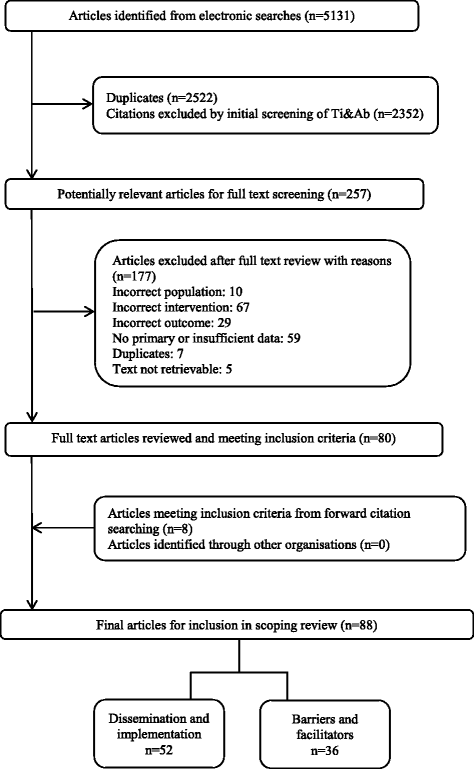Dissemination and implementation research in dementia care: a systematic scoping review and evidence map
- PMID: 28709402
- PMCID: PMC5513053
- DOI: 10.1186/s12877-017-0528-y
Dissemination and implementation research in dementia care: a systematic scoping review and evidence map
Abstract
Background: The need to better understand implementing evidence-informed dementia care has been recognised in multiple priority-setting partnerships. The aim of this scoping review was to give an overview of the state of the evidence on implementation and dissemination of dementia care, and create a systematic evidence map.
Methods: We sought studies that addressed dissemination and implementation strategies or described barriers and facilitators to implementation across dementia stages and care settings. Twelve databases were searched from inception to October 2015 followed by forward citation and grey literature searches. Quantitative studies with a comparative research design and qualitative studies with recognised methods of data collection were included. Titles, abstracts and full texts were screened independently by two reviewers with discrepancies resolved by a third where necessary. Data extraction was performed by one reviewer and checked by a second. Strategies were mapped according to the ERIC compilation.
Results: Eighty-eight studies were included (30 quantitative, 34 qualitative and 24 mixed-methods studies). Approximately 60% of studies reported implementation strategies to improve practice: training and education of professionals (94%), promotion of stakeholder interrelationships (69%) and evaluative strategies (46%) were common; financial strategies were rare (15%). Nearly 70% of studies reported barriers or facilitators of care practices primarily within residential care settings. Organisational factors, including time constraints and increased workload, were recurrent barriers, whereas leadership and managerial support were often reported to promote implementation. Less is known about implementation activities in primary care and hospital settings, or the views and experiences of people with dementia and their family caregivers.
Conclusion: This scoping review and mapping of the evidence reveals a paucity of robust evidence to inform the successful dissemination and implementation of evidence-based dementia care. Further exploration of the most appropriate methods to evaluate and report initiatives to bring about change and of the effectiveness of implementation strategies is necessary if we are to make changes in practice that improve dementia care.
Keywords: Dementia care; Dissemination; Implementation; Scoping review; Strategies.
Conflict of interest statement
Ethics approval and consent to participate
Not applicable.
Competing interests
The authors declare that they have no competing interests.
Publisher’s Note
Springer Nature remains neutral with regard to jurisdictional claims in published maps and institutional affiliations.
Figures


Similar articles
-
Beyond the black stump: rapid reviews of health research issues affecting regional, rural and remote Australia.Med J Aust. 2020 Dec;213 Suppl 11:S3-S32.e1. doi: 10.5694/mja2.50881. Med J Aust. 2020. PMID: 33314144
-
Implementation and dissemination of home and community-based interventions for informal caregivers of people living with dementia: a systematic scoping review protocol.BMJ Open. 2022 Jan 31;12(1):e052324. doi: 10.1136/bmjopen-2021-052324. BMJ Open. 2022. PMID: 35105624 Free PMC article.
-
Implementation and dissemination of home- and community-based interventions for informal caregivers of people living with dementia: a systematic scoping review.Implement Sci. 2023 Nov 8;18(1):60. doi: 10.1186/s13012-023-01314-y. Implement Sci. 2023. PMID: 37940960 Free PMC article.
-
Strategies used for childhood chronic functional constipation: the SUCCESS evidence synthesis.Health Technol Assess. 2024 Jan;28(5):1-266. doi: 10.3310/PLTR9622. Health Technol Assess. 2024. PMID: 38343084 Free PMC article.
-
Reducing unplanned hospital admissions from care homes: a systematic review.Health Soc Care Deliv Res. 2023 Oct;11(18):1-130. doi: 10.3310/KLPW6338. Health Soc Care Deliv Res. 2023. PMID: 37916580
Cited by
-
Barriers, frameworks, and mitigating strategies influencing the dissemination and implementation of health promotion interventions in indigenous communities: a scoping review.Implement Sci. 2022 Feb 21;17(1):18. doi: 10.1186/s13012-022-01190-y. Implement Sci. 2022. PMID: 35189904 Free PMC article.
-
Healthcare and Community Organizations Implementing Evidence-Based Dementia Caregiving Programs: Findings From Best Programs for Caregiving.Gerontologist. 2025 May 10;65(6):gnaf059. doi: 10.1093/geront/gnaf059. Gerontologist. 2025. PMID: 39946285 Free PMC article.
-
Palliative Care Evidence Review Service (PaCERS): a knowledge transfer partnership.Health Res Policy Syst. 2019 Dec 16;17(1):100. doi: 10.1186/s12961-019-0504-4. Health Res Policy Syst. 2019. PMID: 31842886 Free PMC article.
-
Implementing a physical activity project for people with dementia in Germany-Identification of barriers and facilitator using consolidated framework for implementation research (CFIR): A qualitative study.PLoS One. 2023 Aug 9;18(8):e0289737. doi: 10.1371/journal.pone.0289737. eCollection 2023. PLoS One. 2023. PMID: 37556503 Free PMC article.
-
Barriers to the Success of Recreational Groups for Persons With Dementia.J Geriatr Psychiatry Neurol. 2022 Jan;35(1):38-46. doi: 10.1177/0891988720978816. Epub 2020 Dec 4. J Geriatr Psychiatry Neurol. 2022. PMID: 33272092 Free PMC article.
References
-
- American Psychiatric Association (APA). Diagnostic And Statistical Manual Of Mental Disorders DSM-IV-TR Fourth Edition (Text Revision). American Psychiatric Association. 2000.
-
- Alzheimer’s Research UK (ARUK). Defeat dementia: The evidence and a vision for action. London. Available at: http://www.alzheimersresearchuk.org/wpcontent/uploads/2015/01/Defeat-Dem... 2014.
Publication types
MeSH terms
Grants and funding
LinkOut - more resources
Full Text Sources
Other Literature Sources
Medical

